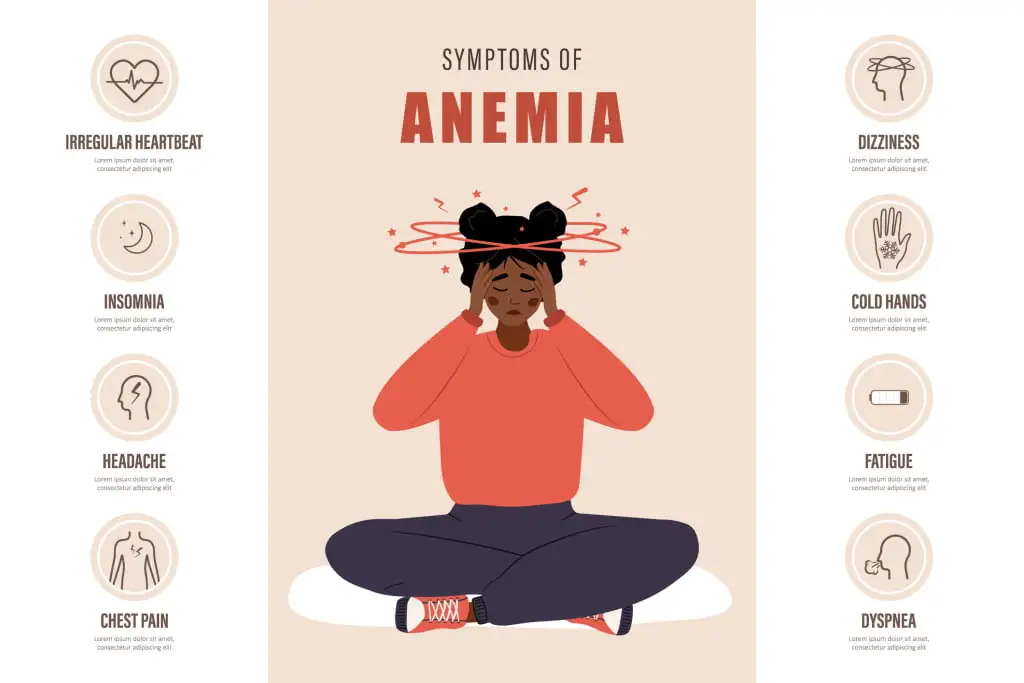Important: We updated this article in September 2024 after fact checking it against current Social Security Administration policies and data. Anemia is a health condition that occurs when an individual doesn’t have enough healthy red blood cells or hemoglobin. Since side effects often accompany it, it’s no surprise you may be unable to work or maintain employment. But is anemia a disability? Certain types definitely can be! We’ll explain how to qualify for Social Security disability benefits, how to apply, pay amounts and more.
Anemia and Disability Benefits: Key Takeaways
- Anemia is a blood condition that occurs when you don’t have enough red blood cells. These cells transport necessary oxygen throughout your body and to your organs.
- Anemia can be a condition on its own or it can be a symptom of other, more dire blood disorders or illnesses. You can have acute (meaning it appears quickly, like after an injury that results in blood loss) or chronic anemia (meaning it is a long-term condition).
- Is anemia a disability? It can be, though it doesn’t have its own disability listing in the Social Security Administration (SSA) Blue Book.
- Can you get disability for anemia? Yes, if you can prove that it keeps you from working for at least 12 months. This only applies if you can meet all technical and medical eligibility requirements for the program in question.
- The average amount of disability benefits for anemia is $1,580 per month.
What Is Anemia?
Anemia is a blood disorder in which a person’s body does not make enough red blood cells.
Anemia can be acute, meaning it happens quickly, such as after a car accident. Acute anemia often resolves without return once your doctor treats it. Chronic anemia, however, is an ongoing condition that isn’t caused by one traumatic event and continues despite treatment.
Anemia can be hereditary or develop because of lifestyle or other health issues. The most common form is iron deficiency anemia (the body needs iron to produce red blood cells).
Some people are at higher risk for anemia, such as pregnant or menstruating women. People whose diets do not contain enough iron are also at risk, as are those who take certain medications.
Statistics from the Centers for Disease Control and Prevention estimate that 3 million people in the United States have anemia.
Anemia Symptoms That Can Limit Your Ability to Work
Anemia causes a number of diverse symptoms that can limit a person’s ability to work, including:
- Fatigue
- Shortness of breath
- Dizziness, which makes driving and operating equipment dangerous
- Cold hands and feet
- Hair loss
- irritability
- Poor concentration
- Weakness
- Chest pain
- Headaches

Different Types of Anemia
Iron Deficiency Anemia
Iron deficiency anemia is when your body doesn’t produce enough red blood cells because it’s missing the needed iron. This typically occurs when a person can’t absorb enough iron from their food or when their diet is lacking in it. It can also happen if you suffer an injury and lose blood quicker than you can replace it.
Vitamin Deficiency Anemia
Unlike the previous type, your body isn’t missing out on iron here; instead, it’s vitamin B12 and folate. This is a problem because without B12 and folate, red blood cells become too large, which impedes their ability to carry enough oxygen.
Sickle Cell Anemia
This is a life-threatening, inherited blood disorder that causes the body to form rigid, sickle-shaped red blood cells. Sickle cell anemia is most common in people of African or Caribbean descent.
Aplastic Anemia
This is a rare bone marrow disorder that can occur at any age when your body stops producing enough blood cells. It can be mild or severe and may worsen over time.
Does Anemia Qualify for Social Security Disability Benefits?
Anemia only qualifies for Social Security disability benefits if it’s severe enough to keep you from working for 12+ months. You also have to meet the other two criteria. First, you must have worked at a job recently enough, and for long enough, where you paid Social Security taxes. Second, you must earn less than $1,620 per month. If you are blind, that amount increases to $2,700.
Do you have sickle cell anemia, thalassemia, aplastic anemia, or hemolytic anemia? If so, those medical conditions are potentially eligible for disability benefits.
But if your anemia isn’t one of the above types, you will have to prove that it is chronic and severe enough to keep you from working. If your anemia is a symptom of another disease or condition — like cancer, for instance — you should file under that condition instead.
Anemia falls under Blue Book Section 7.00, Hematological Disorders.
To qualify for Social Security disability for anemia alone, you must provide medical evidence of one the following:
- A doctor-signed lab report showing you have a blood disorder, OR
- A lab report showing the above, AND a letter or report from your doctor affirming that it is accurate, OR
- a persuasive letter of support from your physician stating that you have a blood disorder diagnosis confirmed by appropriate lab analysis methods.
In addition to the medical records listed above, It’s also very likely the SSA will require that you have a consultative exam.
What to Expect at Your Consultative Exam
This is a medical exam by a doctor the SSA appoints from your state’s Disability Determination Services office. There are many reasons why the SSA may require a consultative exam. Maybe you haven’t seen a doctor recently enough. Or your records might not be convincing enough to prove that you qualify for disability benefits. Finally, you may not have a disability that is listed in the SSA’s Blue Book.
The doctor who performs this consultative exam isn’t there to advise, treat, or counsel you. In fact, that doctor’s job is to help the SSA detect and stop fraudulent disability cases.
You won’t know this doctor or their staff, and the appointment will likely only last 10-15 minutes. The doctor and staff won’t just examine you, either. Instead, they’ll watch and evaluate what you do and how you act from the second you enter the waiting room. In some instances, observation begins in the parking lot. So it’s best to always be on your best behavior.
Pro Tip: This exam is always free, so you don’t have to worry about cost. But if you skip this exam, the SSA will deny you any benefits.
How to File Your Anemia Disability Claim
The Social Security Administration provides several ways to file for disability. For SSDI benefits, you can do so online, by phone, or in person at your local SSA office. (You cannot apply for SSI disability online.) For the best results, though, it’s smart to file through an attorney for free. Not only can an experienced attorney pull the correct medical documentation, but they’re familiar with appeals if you’ve already been denied once.
How Much Does Disability for Anemia Pay Each Month?
The maximum monthly amount of Social Security Disability Insurance (SSDI) in 2025 is $4,018 per month. The average payment, however, is much less: $1,580. You must also have at least 40 Social Security work credits to qualify for SSDI.
If you instead qualify for SSI, or Supplemental Security Income, you may be eligible for up to $967 each month if you are a single eligible person. SSI disability pays $1,450 for eligible couples.
To qualify for SSI, you must be 65 or older, blind, or disabled and have limited financial resources. Unlike Social Security disability benefits, SSI does not review your past work history. Instead, the Social Security Administration will evaluate your income and financial assets.
Learn about other types of disability benefits that may be available to you.
Tips to Maintain Healthy Red Blood Cells
Eating a diet full of nutrient-dense foods is one way to maintain healthy red blood cells. Lean meat, poultry, seafood, nuts, beans, lentils, raisins, iron-fortified bread and cereals are all rich sources.
Foods high in B12 and folic acid include:
- Spinach
- Liver
- Brussels sprouts
- Meat
- Poultry
- Fish
- Eggs
- Dairy products, such as milk and cheese
Supplements can also help maintain healthy red blood cells, especially if you have any food allergies or other dietary restrictions.
Eliminating alcohol and exercising regularly can also help promote healthy red blood cells.
Learn if You May Qualify During a Free Social Security Disability Claim Evaluation
Disability applicants who work with a Social Security attorney are 3x more likely to get benefits paid within 6 months. Not sure you can afford a disability attorney? All of them work on contingency. This means that you’ll owe $0 if your Social Security disability application isn’t successful. But if you do get SSD payments, then you’ll only owe one small fee afterwards.
All disability lawyers in our network offer an initial free, no-obligation consultation. That means you can get answers to all your questions and find out if you may qualify for Social Security disability benefits before you apply. Even better, we can match you with someone local who can discuss your claim right away, over the phone.
Ready to connect? Click the button below to start your free online benefits quiz now and see if you may qualify:
Get Your Free Benefits Evaluation
Lisa Allen is a writer and editor who lives in suburban Kansas City. She holds MFAs in Creative Nonfiction and Poetry, both from the Solstice Low-Residency Program in Creative Writing at Pine Manor College. Prior to becoming a writer, Lisa worked as a paralegal, where she specialized in real estate in and around Chicago.

